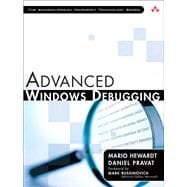
Note: Supplemental materials are not guaranteed with Rental or Used book purchases.
Purchase Benefits
What is included with this book?
Mario Hewardt is a senior design engineer with Microsoft, and has worked extensively in the Windows system level development area for the last nine years. He is currently involved with designing and implementing the next generation management protocol for Windows Longhorn.
Daniel Pravat is a senior design engineer with Microsoft and has worked in the Windows division, primarily within the Windows management area. He is currently leading a development team that has the responsibility of shipping the most reliable management platform for Windows Longhorn.
| Overview | |
| Introduction to the Tools | |
| Introduction to the Debuggers | |
| Debugger Uncovered | |
| Managing Symbol and Source Files | |
| Applied Debugging | |
| Memory Corruptions | |
| Stacks | |
| Memory Corruptions | |
| Heaps | |
| Security | |
| Inter-process Communication | |
| Resource Leaks | |
| Synchronization | |
| Advanced Topics | |
| Writing Custom Debugger Extensions | |
| 64-bit Debugging | |
| Postmortem Debugging | |
| Power Tools | |
| Windows Vista Fundamentals | |
| Application Verifier Test Settings | |
| Index | |
| Table of Contents provided by Publisher. All Rights Reserved. |
The New copy of this book will include any supplemental materials advertised. Please check the title of the book to determine if it should include any access cards, study guides, lab manuals, CDs, etc.
The Used, Rental and eBook copies of this book are not guaranteed to include any supplemental materials. Typically, only the book itself is included. This is true even if the title states it includes any access cards, study guides, lab manuals, CDs, etc.